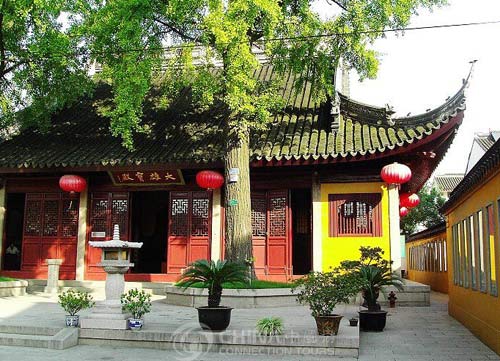Dinghui Temple, first built in the Eastern Han Dynasty (25 - 220), is the largest of all the temples on Jiaoshan Hill. It was originally named Puji Temple and was renamed as Puji Buddhist Temple in the Song Dynasty and Jiaoshan Temple in the Yuan Dynasty. During the Qing Dynasty (1644 - 1911), when Emperor Kangxi made a tour of this mountain, its named was changed to Dinghui Temple, the one we used today.
The temple lies on the hill and is magnificent in scale. During the Ming Dynasty (1368 - 1644) when it reached its golden ages, it has 98 halls, 3000 monks and 18 additional temples beside it. The mountain gate of Dinghui Temple, simple and elegant, was open to the south. A pair of stone lion dated from the Ming Dynasty guards the gate and a tablet written with "Dinghui Temple in Jiaoshan" was hung above the gate.
 Daxiongbaodian Hall is the main building in this temple. It keeps the style of the Ming and is magnificent and grand with an ornately painted and carved ceiling, red pillars, and cool stone floors. Statues of Sakyamuni, Akshobhya and Amitabha are enshrined inside, with eighteen arhats line up on both sides. All these figures are various and vivid in expressions and gestures. In front of the hall are two 500-year-old ginkgo trees. Having experienced rains and winds for thousands of years, they are still exuberant and verdant.
Daxiongbaodian Hall is the main building in this temple. It keeps the style of the Ming and is magnificent and grand with an ornately painted and carved ceiling, red pillars, and cool stone floors. Statues of Sakyamuni, Akshobhya and Amitabha are enshrined inside, with eighteen arhats line up on both sides. All these figures are various and vivid in expressions and gestures. In front of the hall are two 500-year-old ginkgo trees. Having experienced rains and winds for thousands of years, they are still exuberant and verdant.
To the southwest of Dinghui Temple is Huayan Pavilion, which is 2 stories high. On its eastern, southern and western sides, one can enjoy the scenery of the Yangtze River. It is also one of the three well-known places in Zhenjiang for admiring the full moon.

